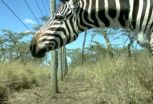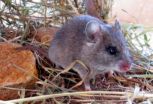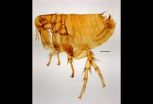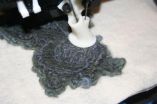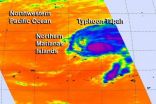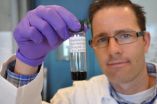(Press-News.org) In the Middle Ages, fleas carried by rats were responsible for spreading the Black Plague. Today in East Africa, they remain important vectors of plague and many other diseases, including Bartonellosis, a potentially dangerous human pathogen.
Research by Hillary Young, assistant professor in UC Santa Barbara's Department of Ecology, Evolution and Marine Biology, directly links large wildlife decline to an increased risk of human disease via changes in rodent populations. The findings appear today in the Proceedings of the National Academy of Sciences Early Online Edition.
With an East African savanna ecosystem as their research site, Young and her colleagues examined the relationship between the loss of large wildlife — defaunation — and the risk of human disease. In this case, they analyzed Bartonellosis, a group of bacterial pathogens which can cause endocarditis, spleen and liver damage and memory loss.
"We were able to demonstrate that declines in large wildlife can cause an increase in the risk for diseases that are spread between animals and humans," said Young. "This spike in disease risk results from explosions in the number of rodents that benefit from the removal of the larger animals."
The researchers discovered this effect by using powerful electric fences to experimentally exclude large species like elephants, giraffe and zebra from study plots in Kenya. Inside these plots, rodents doubled in number. More rodents meant more fleas, and genetic screens of these fleas revealed that they carried significantly numbers of disease-causing pathogens.
The study was concentrated in an area where rodent-borne disease is common and sometimes fatal. According to Young, these rodent outbreaks and associated increases in disease risk may be exacerbating health problems in parts of Africa where diminishing wildlife populations are rife.
"This same effect, however, can occur almost anywhere there are large wildlife declines," Young said. "This phenomena that we call rodentation — the proliferation of rodents triggered by large wildlife loss — has been observed in sites around the world."
Downturns in wildlife numbers can cause rodent increases in a variety of ways, including by providing more access to food and better shelter. "The result is that we expect that the loss of large animals may lead to a general increase in human risk of rodent borne disease in a wide range of landscapes," Young said.
"In this study, we show the causal relationship between disturbance and disease is alarmingly straightforward," she added. "We knock out the large members of ecosystems, and the small species, which generally interact more closely with humans, dramatically increase in number, ultimately brewing up more disease among their ranks.
The study provides ecosystem managers with yet another reason to protect large and at-risk wildlife species. "Elephants are an irreplaceable part of our global biodiversity portfolio," Young said, "but they also appear to be circuitously protecting us from disease."
INFORMATION:
Also involved in the study was Douglas J. McCauley, assistant professor in the Department of Ecology, Evolution and Marine Biology at UC Santa Barbara. Other participants were Rodolfo Dirzo of Stanford University; Kristofer M. Helgen of the National Museum of Natural History, Smithsonian Institution; Sarah A. Billeter, Michael Y. Kosoy and Lynn M. Osikowicz of the Division of Vector-Borne Infectious Diseases, National Center for Infectious Diseases, Centers for Disease Control and Prevention; Daniel J Salkeld of Colorado State University, Fort Collins, and the Woods Institute for the Environment at Stanford University; Truman P. Young of UC Davis; and Katharina Dittmar of the University at Buffalo, The State University of New York.
Declines in large wildlife lead to increases in disease risk
UCSB professor's research in East Africa shows biodiversity loss heightens the risk of disease transmission from animals to humans
2014-04-29
ELSE PRESS RELEASES FROM THIS DATE:
Chronic stress heightens vulnerability to diet-related metabolic risk
2014-04-29
New research out of UC San Francisco is the first to demonstrate that highly stressed people who eat a lot of high-fat, high-sugar food are more prone to health risks than low-stress people who eat the same amount of unhealthy food.
"Chronic stress can play an important role in influencing biology, and it's critical to understand the exact pathways through which it works." said Kirstin Aschbacher, PhD, an assistant professor in the UCSF Department of Psychiatry and lead author. "Many people think a calorie is a calorie, but this study suggests that two women who eat the ...
GWAS study ties ABCC9 anomalies, sulfonylurea exposure to HS-Aging
2014-04-29
LEXINGTON, Ky. (April 29, 2014) -- A genome-wide association study (GWAS) led by Peter Nelson, MD, PhD, of the Sanders-Brown Center on Aging at the University of Kentucky, and David Fardo, PhD, of UK's Department of Biostatistics, has provided new insight into Hippocampal Sclerosis of Aging (HS-A), a common disease affecting the elderly.
Researchers from 16 different institutions compared 363 persons with autopsy-proven HS-A to a control group of 2,303 other individuals in an attempt to identify genetic predisposition to HS-Aging.
Dr. Nelson and his team found that ...
Carnegie Mellon-Disney researcher invents 3-D printing technique for making cuddly stuff
2014-04-29
PITTSBURGH—Soft and cuddly aren't words used to describe the plastic or metal things typically produced by today's 3D printers. But a new type of printer developed by Carnegie Mellon University and Disney Research Pittsburgh can turn wool and wool blend yarns into fabric objects that people might actually enjoy touching.
The device looks something like a cross between a 3D printer and a sewing machine and produces 3D objects made of a form of loose felt. Scott Hudson, a professor in CMU's Human-Computer Interaction Institute who developed the felting printer with Disney ...
Beyond graphene: Controlling properties of 2-D materials
2014-04-29
The isolation of graphene at the University in 2004 led to the discovery of many other 2D crystals. While graphene has an unrivalled set of superlatives, these crystals cover a large range of properties: from the most conductive to isolating, from transparent to optically active.
The next step is to combine several of these crystals in a 3D stack. This way, one can create 'heterostructures' with novel functionalities – capable of delivering applications as yet beyond the imagination of scientists and commercial partners.
The first examples of such heterostructures already ...
Scripps Florida scientists reveal molecular secrets behind resveratrol's health benefits
2014-04-29
JUPITER, FL, April 29, 2014 – Resveratrol has been much in the news as the component of grapes and red wine associated with reducing "bad cholesterol," heart disease and some types of cancer. Also found in blueberries, cranberries, mulberries, peanuts and pistachios, resveratrol is associated with beneficial health effects in aging, inflammation and metabolism.
Scientists from the Florida campus of The Scripps Research Institute (TSRI) have now identified one of the molecular pathways that resveratrol uses to achieve its beneficial action. They found that resveratrol ...
Tapah through infrared satellite eyes: Now a typhoon
2014-04-29
Tropical Storm Tapah strengthened since April 28 and early on April 29, the storm reached typhoon strength. From its orbit in space, NASA's Aqua satellite zoomed over Tapah and the AIRS instrument captured infrared data on the storm that showed the location of its strongest thunderstorms.
The U.S. National Weather Service in Guam noted that a tropical storm warning and a typhoon watch continues for Alamagan and Pagan. For details on the advisory, visit: http://www.prh.noaa.gov/data/GUM/HLSPQ1
The Atmospheric Infrared Sounder (AIRS) instrument that flies aboard NASA's ...
Graphene not all good
2014-04-29
RIVERSIDE, Calif. — In a first-of-its-kind study of how a material some think could transform the electronics industry moves in water, researchers at the University of California, Riverside Bourns College of Engineering found graphene oxide nanoparticles are very mobile in lakes or streams and therefore likely to cause negative environmental impacts if released.
Graphene oxide nanoparticles are an oxidized form of graphene, a single layer of carbon atoms prized for its strength, conductivity and flexibility. Applications for graphene include everything from cell phones ...
Rice U. study: How state ownership hampered entrepreneurship in Chinese companies
2014-04-29
HOUSTON – (April 29, 2014) – For state-owned companies in China, the significant detriment in employing innovation may be linked to the company's ownership structure, according to a new study on Chinese entrepreneurship by Chinese business experts at Rice University, the University of Hong Kong, Texas Christian University, Jilin University and Shantou University.
The researchers found that the more equity the state owned of a company, the less likely the company was to engage in strategic entrepreneurship (investing in research and development and other innovations) to ...
Anti-smoking TV ads should use anger, Dartmouth-Cornell study suggests
2014-04-29
Anti-smoking television advertisements that appeal to viewers' emotions are more persuasive when they use anger rather than sadness, a Dartmouth-Cornell study suggests.
The study appears in the Journal of Health Communication. A PDF is available on request.
Previous studies have shown emotional expression is a crucial part of persuasion, and that audience members' perceptions of emotions affect their attitudes and behaviors. Previous research also has shown anti-smoking TV ads that convey negative emotions such as anger and sadness are more effective than non-emotional ...
'Feel good' factor higher when you own, not just use, luxury items
2014-04-29
It means more to people to own a luxury product or brand than to have the privilege of simply using one. Just using an affordable luxury item you don't own can, in fact, dampen the feel good factor that normally surrounds such products, say Liselot Hudders and Mario Pandelaere of Ghent University in Belgium. The research was published in Springer's journal Applied Research in Quality of Life.
To test the link between luxury consumption and subjective well-being, the researchers presented 307 study participants with luxury and ordinary versions of either a durable pen, ...
LAST 30 PRESS RELEASES:
Groundbreaking discovery turns household plastic recycling into anti-cancer medication
Blocking a key inflammatory pathway improves liver structure and vascular function in cirrhosis, study finds
Continuous spread: Raccoon roundworm detected in nine European countries
HKUST Engineering researchers developed a novel photodetector to enhance the performance of on-chip light monitoring
Strategic river sensors could have forewarned of Texas Camp flood disaster
Drone sampling of whale breath reveals first evidence of potentially deadly virus in Arctic
Roman soldiers defending Hadrian’s Wall infected by parasites, study finds
Pinochet’s prisoners were tormented with music but still found solace in it, a new book reveals
Fertility remains high in rural Tanzania despite access to family planning
AI-assisted device can improve autism care access
Kinetic careers
Uncovering how parasitic plants avoid attacking themselves to improve crop resistance
Nanoparticle vaccine strategy could protect against Ebola and other deadly filoviruses
Study finds brain care score can predict risk of stroke across racial groups
Key lung immune cells can intensify allergic reactions
Do hormones explain why women experience more gut pain?
New materials conduct ions in solids as easily as in liquids
Breakthrough of the Year: Renewable energy begins to eclipse fossil fuel-based sources
LLM use is reshaping scientific enterprise by increasing output, reducing quality and more
Introducing LightGen, a chip for ultra-fast, ultra-efficient generative AI
Astronomers see fireworks from violent collisions around nearby star
ACC/AHA issue new guideline on managing congenital heart disease in adults
Cosmic crash caught on camera
Is talented youth nurtured the wrong way? New study shows: top performers develop differently than assumed
Ants: An untapped resource in the development of antibiotics?
Archaeologists use AI to create prehistoric video game
Mitochondria migrate toward the cell membrane in response to high glucose levels
Tiny viral switch offers hope against drug-resistant bacteria
Most parents aware of early peanut introduction guidelines, but confused about details
HPV vaccine can protect against severe lesions of the vulva and vagina
[Press-News.org] Declines in large wildlife lead to increases in disease riskUCSB professor's research in East Africa shows biodiversity loss heightens the risk of disease transmission from animals to humans
